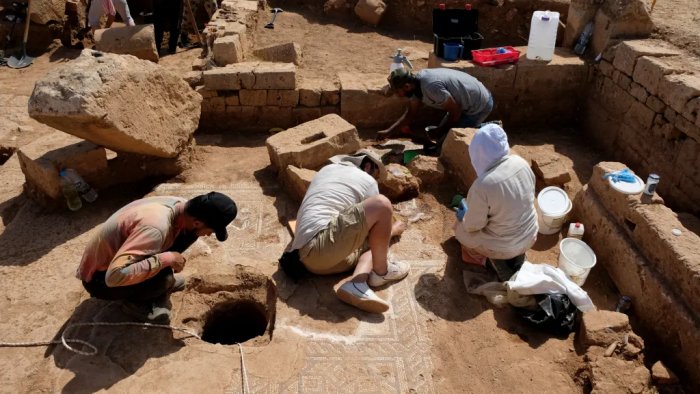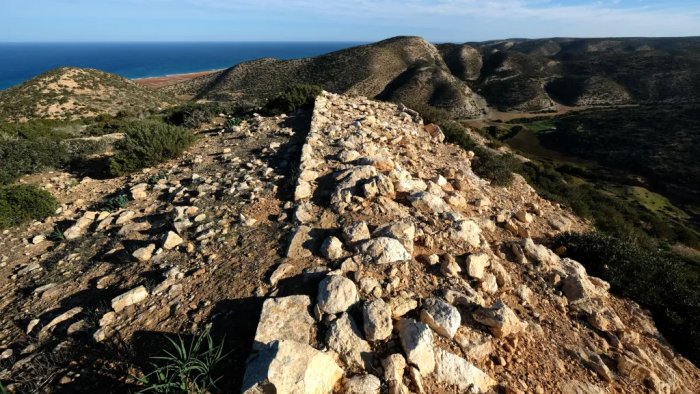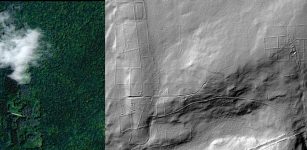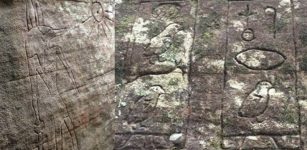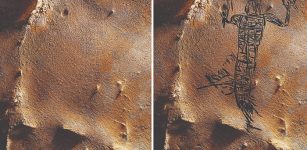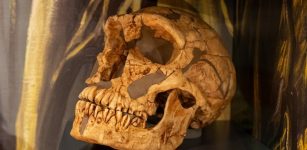Surprising Mask Of A Human Face Found On Cistern Wall In The Ancient City Of Ptolemais
Conny Waters – MessageToEagle.com – In the ancient city of Ptolemais, situated on the Mediterranean coast, archaeologists have uncovered a section of a city residence featuring an advanced system for collecting drinking water. Among their findings is a mysterious mask depicting a human face. Researchers are now beginning to study the acropolis in this area.
Acropolis of Ptolemais. Credit: Szymon Lenarczyk
Ptolemais ranks among the largest ancient Greek cities and is located in Cyrenaica, a historical region currently part of northeastern Libya. The city was established by Egyptian rulers from the Ptolemaic dynasty during the late 4th or 3rd century BC. It remained inhabited until it fell during the Arab conquest in the 7th century AD.
The archaeological excavations are being conducted by scientists from the Faculty of Archaeology at the University of Warsaw. These researchers resumed their work at this site in 2023 after a 13-year hiatus due to disruptions caused by the Libyan civil war.
“Through comprehensive archaeological research in Ptolemais, we aim to learn about the past of this Hellenistic-Roman city and the lives of its inhabitants. We are conducting this research on a micro-scale by excavating a carefully selected quarter of the urban development, and on a macro scale by documenting the entire city and its rural territory using modern non-invasive methods,” Dr. Piotr Jaworski, head of the Polish Archaeological Mission to Ptolemais, told Science in Poland.
The Residence Of A Dignitary
During the June 2024 excavations, archaeologists from the University of Warsaw uncovered a significant section of a city residence that once belonged to a dignitary. The initial phase of its use is dated to the late 2nd to 3rd century A.D. A notable feature in the eastern area of this house was a small peristyle, or inner courtyard, which was surrounded by various rooms, including a kitchen, a staircase leading to the first floor, and a room with an often-repaired mosaic, as described by Dr. Jaworski.
Exploration and conservation of the ruins of a house from the early 3rd century in Ptolemais. Credit: Piotr Jaworski
The residence boasted an advanced system for collecting drinking water; its central element was the peristyle pool (impluvium), designed to collect rainwater and channel it into two underground cisterns. However, this structure suffered considerable damage due to earthquakes that affected Cyrenaica at least twice in the latter half of the 3rd century. It is believed that reconstruction took place during the late Roman period.
This hypothesis is supported by three stone containers near the entrance—similar features are common in many affluent houses from late antiquity in Cyrenaica and were likely used for depositing taxes in natural goods or gifts. Additionally, it appears that its owner conducted public activities at this residence.
Mysterious Face
This season, the most surprising find for archaeologists was a human face modeled in a plastic mass of hydraulic mortar, which was used to cover the walls of one of the water cisterns. As described by archaeologists, the mask lacks any attributes that would allow its identification. Also, the lack of known analogies gives a wide field for various interpretations.
Mask on the cistern wall. Credit: Anna Tomkowska
“The face discovered in the cistern resembles human faces carved on the walls of the Libyan sanctuary in Slonta, south of Cyrene. It’s possible that the house’s owner, or those involved in creating the image, were of Libyan origin. Epigraphic sources reveal that from at least the 1st century BC, Greek cities in Cyrenaica granted citizenship to quickly assimilating Libyan elites. However, this remains speculative,” explained Dr. Piotr Jaworski.
Acropolis Research
At the end of last year, a non-invasive research project was initiated by the science team to study the city’s acropolis, with plans to continue for several years. Historically, Greek cities with advantageous natural features, like elevated terrain for defense purposes, typically had an acropolis. These structures were usually within city walls and often fortified with citadels; this was also true for Ptolemais. The local acropolis is 285 meters above sea level on an 11-hectare triangular plateau. The city’s defensive walls protect it on two sides and an additional wall to the north, allowing it to be defended independently if necessary and providing protection to all city residents. The southernmost section contains a small fort that served as a final refuge.
City walls surrounding the acropolis from the southeast. Credit: Piotr Jaworski
“Even the initial reconnaissance of the acropolis shows the excellent use of its natural defensive features by ancient planners,” said Dr. Szymon Lenarczyk, head of the project, in a press release.
The acropolis had an excellent drinking water supply system due to numerous cisterns and wells throughout its area. A theater was built on its northern slope, while a hippodrome lay at its base. Despite rocky elevations covering nearly one-third of the city’s surface within its walls, comprehensive archaeological exploration has been limited. In the late 1950s, only preliminary studies of the acropolis’s defense system were conducted by a University of Michigan expedition led by archaeologist Carl Hermann Kraeling.
See also: More Archaeology News
Currently, archaeologists from the University of Warsaw have created a three-dimensional terrain model to guide future research efforts and identify appropriate non-invasive field prospecting methods. In upcoming research seasons, scientists aim to learn more about these structures’ functions—whether residential buildings or places of worship existed within the Acropolis grounds.
Written by Conny Waters – MessageToEagle.com – AncientPages.com Staff Writer


